.
Stirring events agitated Launceston at the end of the eighteenth century. In 1794, when a French invasion was daily expected, corps of volunteers were raised throughout the country, and in Cornwall
Launceston was the first to move. Edward Archer, of Trelaske, was then High Sheriff, and his brother,
Samuel Archer (who had retired as Lieutenant-Colonel from the 3rd Foot Guards, and was then residing at Tremeale) was placed as Major Commandant at the head of two companies of infantry of fifty men each, one from Lewannick, Northhill, South Petherwin, and Lezant, and the other from Launceston. A troop of volunteer cavalry also was raised, the muster-roll of which is dated June 4, 1794, and fifty-one out of whose fifty-five members resided in Launceston or St. Stephens. John Cudlipp was the captain of the latter, his subalterns probably being Coryndon Rowe and John Martyn, jun., while Captain Spettigue acted for the infantry under Colonel Archer, whose commission as Major Commandant was dated June 9, 1794. Official record of the work is to be found in the minutes of a county meeting held at Lostwithiel on July 18 of the same year, the High Sheriff presiding, which resolved “That it appearing to this meeting the gentlemen of Launceston have raised a complete troop of cavalry and also of infantry, it is ordered that a further sum of £50 be immediately paid to the captain of the said troop of horse.” Colonel Archer’s “green linnets,” as they were popularly known from the hue of their clothes, were twelve months later, on June 4, 1795 (the King’s birthday), presented with colours, the gift of the Duchess of Northumberland, the occasion being celebrated by a sermon of the Rev. William Carpenter, D.D., the vicar of Lewannick, perpetual curate of St. Mary Magdalene, and son of Joseph Carpenter, a Launceston Alderman of forty years before. At the end of the Napoleonic wars the units were disbanded.
On April 29th 1859 a war (the second Italian war of independence) between Austria against Sardinia and France broke out. The war which the Austrian’s eventually lost, lasted for less than six months and laid the foundations for a modern Italian state. More than that, it raised concerns in Britain of the overall aims of France and the second French Empire of Napoleon III. Although Britain retained the largest Navy those concerns were to the defence of the country should there be an invasion. This resulted in meetings throughout the country to establish volunteer corps. The Government of the day were somewhat luke warm in their encouragement of the movement.Taking council from old officers who scoffed at the idea of citizen soldiers being of any use against regular forces. However, such was the public demand, the pressure to do something was something the Government could resist, and after much discussion in and out of Parliament the War Minister agreed to furnish the Volunteer forces with arms. The people of Launceston were no different from their fellow countrymen and a meeting was held on October 10th 1859 at the Launceston council chamber where a Mr. Edward Baring Gould made an impassioned speech imploring volunteers to come forward to form the first Launceston Volunteer Corp.

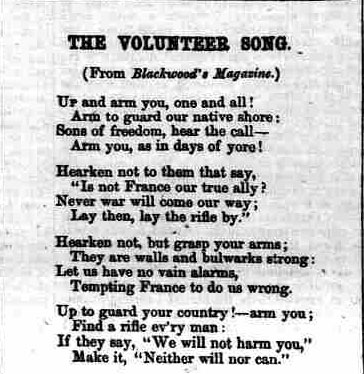

The chairman of the meeting Mr. Edward Archer laid out the requirement’s for being a member of the volunteer’s was that 24 days training per year would be mandatory and those that conformed would be exempt for the ballot for the militia. Any member could resign from the corps. providing they gave 14 days notice. A model of the rifle to be used was exhibited, which could be purchased for £3 5s, and paid for, if required, by 1s 3d a week.
At the meetings end 14 individuals enrolled, making a total of 17. The first members of the corps. were Messrs Thomas Ching (the first to enroll), T. C. Brendon, C. Brendon, A. B. Collier (the second to enroll), W. Dingle, J. Dingley, G. Higgs, W. Orchard, F. Thorne, W. Angwin, J. Oke, G. F. Ham, R. Wevill, J. Huggins, E. Jury, H. Cannon, H. Symons, and R. Hocking. Mr. Baring Gould agreed to command the newly formed corps. Within two months the number had swelled to 76 members. Mr. D. Hanson was unanimously elected Lieutenant and the first drill-sergeant was a sergeant of Militia who was quartered in the town, by the name of Evans but he was soon replaced with Mr. Job Gould. Sergeant Gould was succeeded by an ex Marine, Sergeant Fidler. John Dingley was made ensign and Arthur Collier who had declined the offer of a commission as officer, was made senior sergeant.
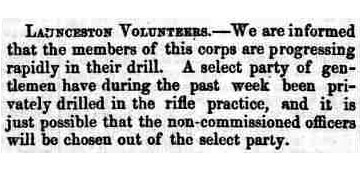
As the Volunteer force became a reality the Government made concessions, the most important of which was a capitation grant per head on all efficients. This furnished sufficient funds to pay for uniforms, and further, the sergeant instructor was paid as a staff sergeant of the army.
By March 1860 the Government supply of rifles had been received and Mr. Aunger and Mr. Couch had been given the contract to make the uniforms.The arms supplied were muzzle-loading rifle muskets – the same as those used by the regulars at that time. However later that month Captain Baring Gould retired from his command after taking on a similar role with the Tavistock Volunteer Corps. Mr. Edward Archer was elected in his place but later when he had been informed that the election proceedings was irregular and unauthorised, he rescinded his acceptance.
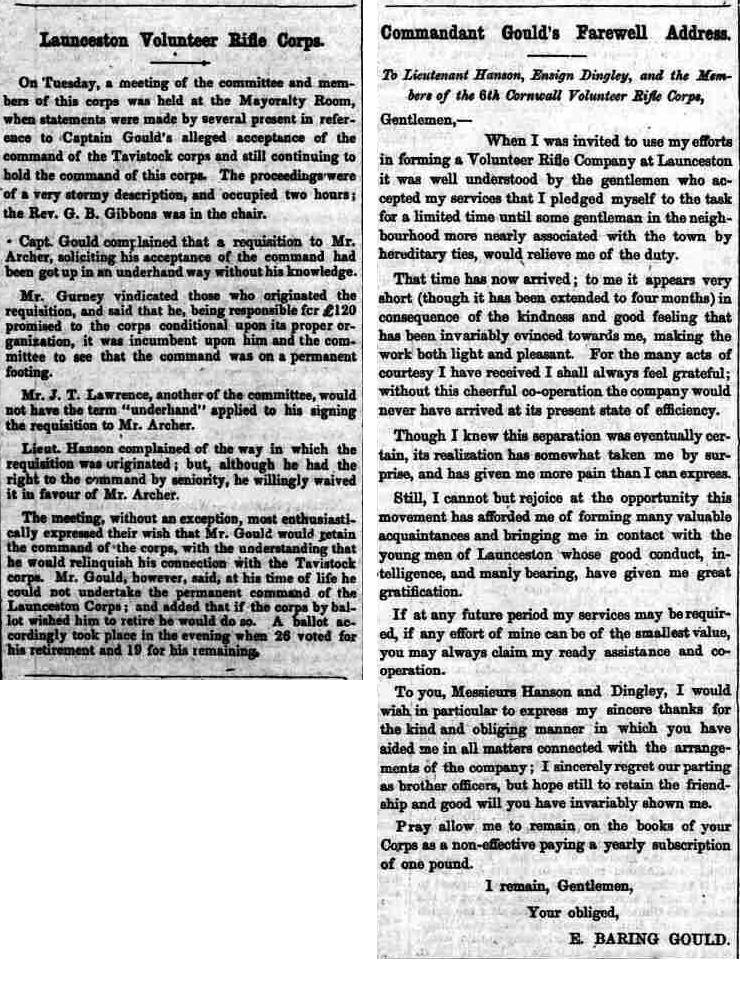
However, there was some discourse in the manner of the proceedings and how he was replaced, Mr. Baring Gould accused the committee of being underhand. Not for the first time nor the last, Mr. Charles Gurney was at the head of the argument and he took to correspondence in the Launceston Weekly News of March 24th 1860 (below) accusing Baring Gould, Lieutenant Hanson and Dr. David Thompson of being argumentative and having their own agenda’s.
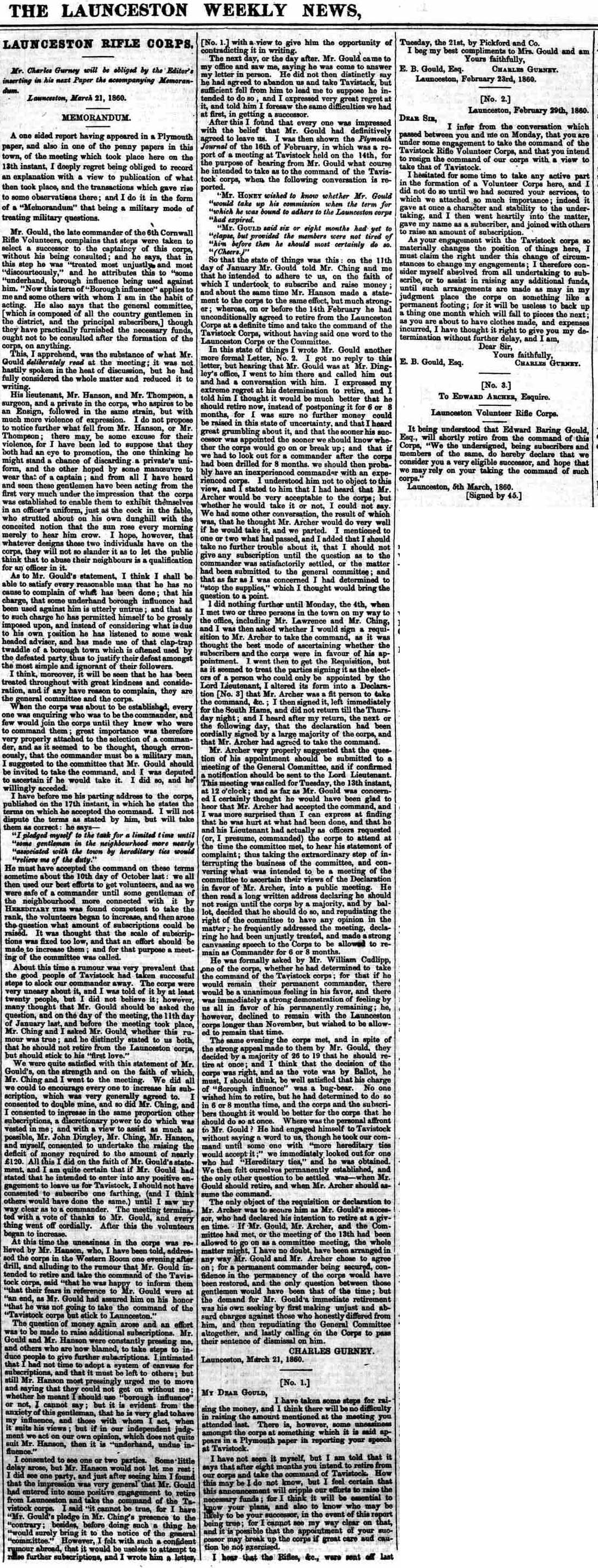
Mr. Baring Gould and Dr. Thompson both responded to Mr. Gurney’s accusations in the following weeks newspaper (below). The same week at the Armoury Room, the corps assembled and on a proposition of Lieuntenant Hanson, seconded by Ensign Dingley, a unanimous invitation was given to Edward Archer to take command which he duly accepted.

Over the coming months new members were added from Lewannick and Altarnun, and in the June a recruitment meeting was held in Lezant whereby three more men volunteered. On July 18th the corps. had their first government inspection where they paraded on the Castle Green to Major Hume, and Adjutant Barrett. Major Hume complimented them on their high state of efficiency they had already reached, and the satisfaction they had given him.
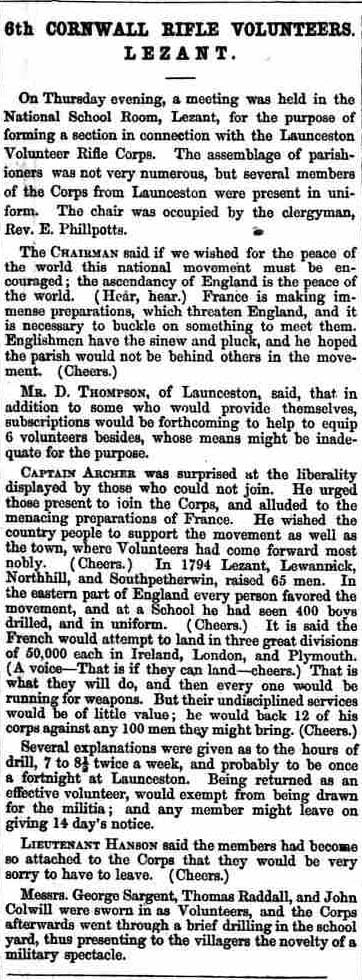
As the Volunteer force developed a fresh Act of Parliament became necessary. The old Act under which the force was enrolled was passed in the early part of the 19th century, when a real invasion was contemplated by Napoleon. It did not meet the requirements of the Volunteers sixty years later. Almost every town in Cornwall had raised a company of Volunteers, either infantry or artillery, and the infantry were divided into two administrative battalions, one for the west and the other for the east of the county. The Launceston Company was number 6.
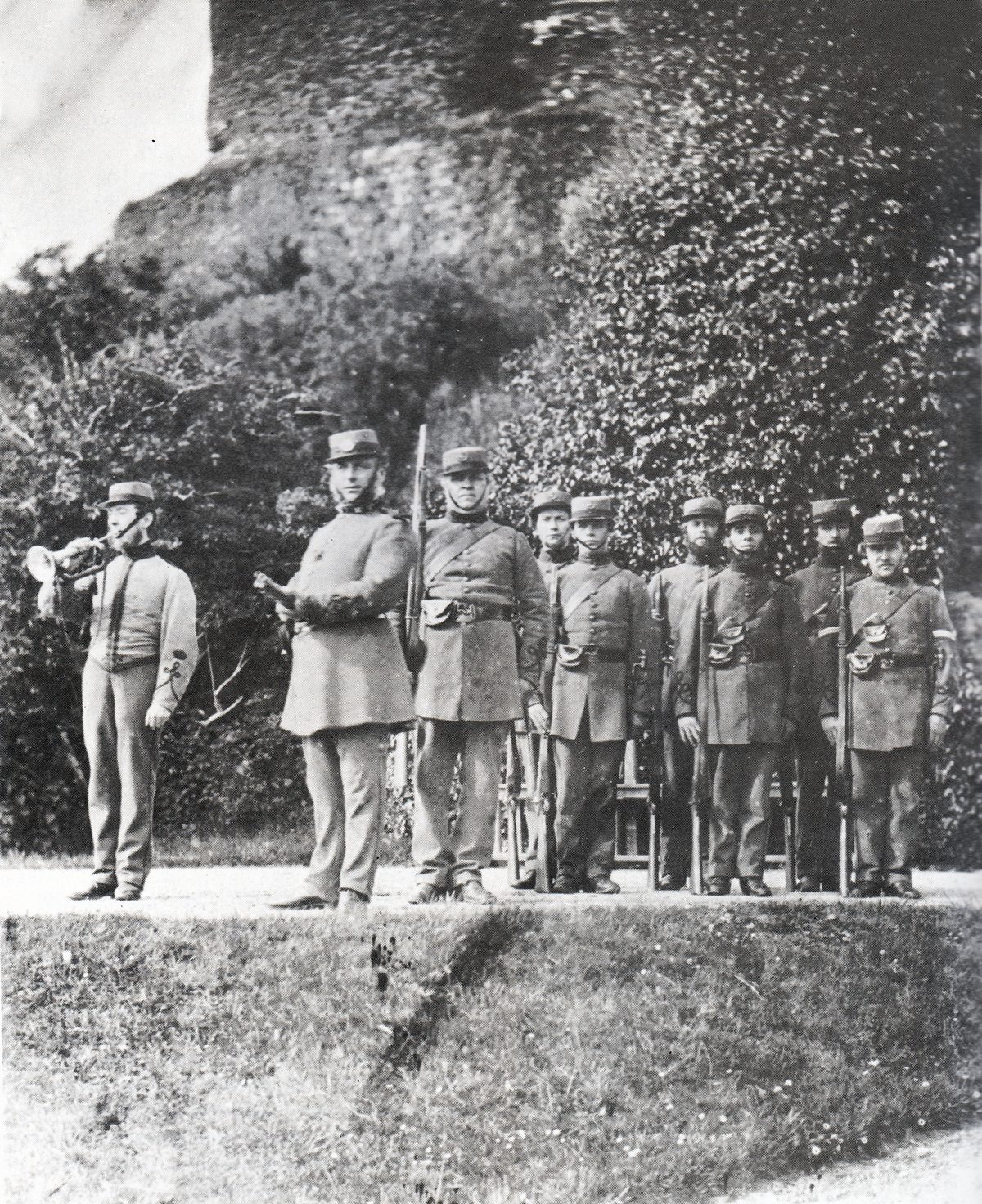
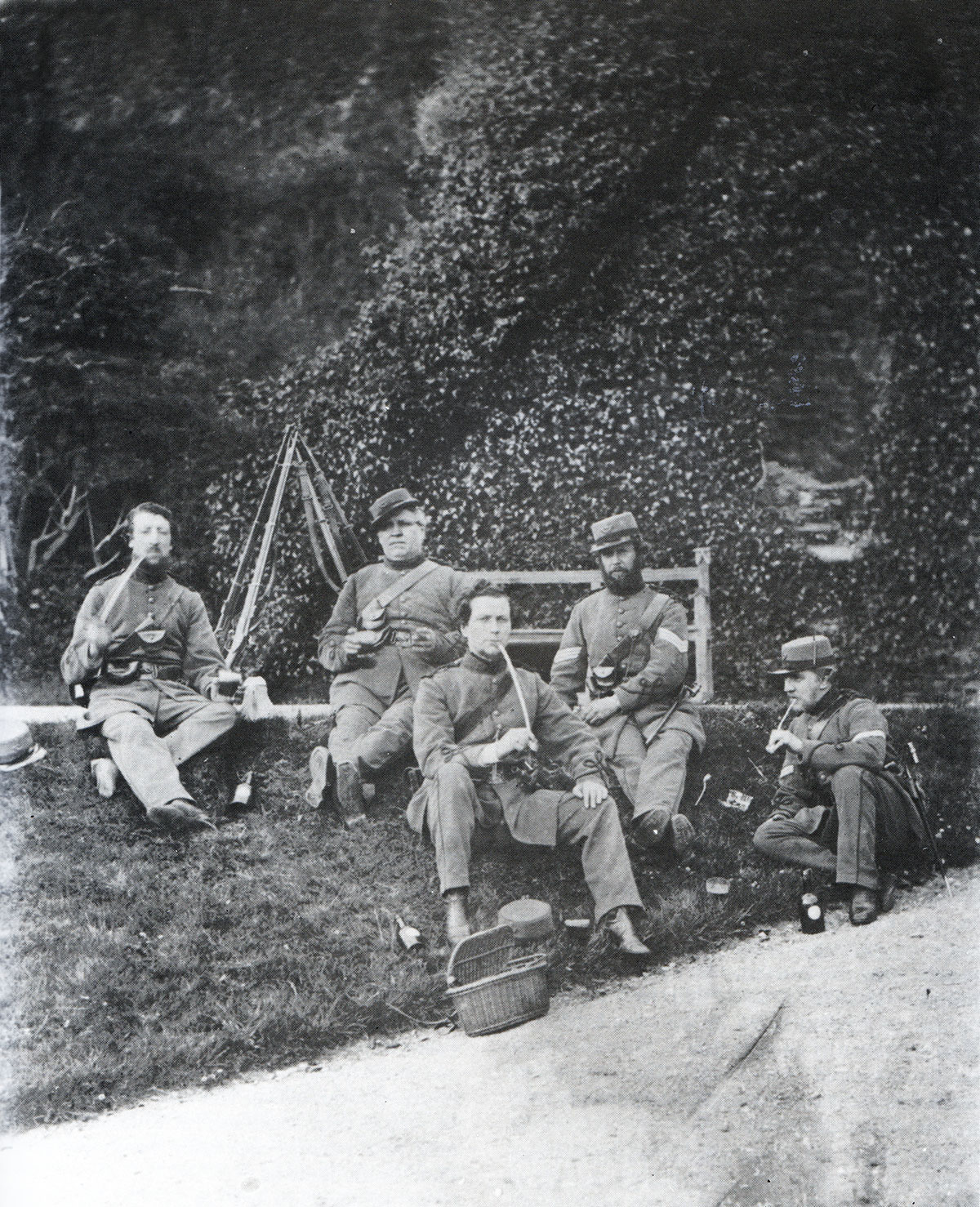
The first commanding officer of the east battalion was Colonel Cocks, and ex’Guardsman who was appointed in the spring of 1860, and Captain Barnett, late of the 42nd Highlanders, was appointed adjutant. Adjutants of Volunteers were staff officers of the Army, and were in no sense Volunteers. Captain Archer was promoted to the rank of Major in 1861, and about the same time Lieutenant Hanson resigned, leaving two vacancies in the commissioned ranks. Ensign Dingley became captain and Arthur Collier finally took up his first commission as lieutenant, which he held until 1872, when he was appointed captain. Dr. Thompson also received his first commission in 1860, and remained for over 30 years as medical officer, retiring with the rank of colonel. The other officers were Mr. Copland Cowlard, Mr. John Ching and Dr. Clay. From 1864 to 1872, Mr. P. F. Simcoe commanded the company. Mr. Marsack received his first commission as second lieutenant in 1879 and he went on to command the battalion as lieutenant-colonel in 1907. Major Archer became lieutenant-colonel commanding the battalion in 1862, and retired in 1874 with the rank of colonel.
In 1871 the Volunteers were invited for the first time to take part in manoeuvre’s with regular forces at Ringmoor Down, near Sheepstor on Dartmoor. Despite misgivings by the Adjutant, lieutenant Collier took 50 men for eight days. In preparation for the camp, lieutenant Collier exercised the men in pitching and striking tents. He wrote in 1906 “I remember an old farmer watching the tent drill on the Castle Green with great interest, and when I explained that the Volunteers would have to sleep in them he said ‘I baint going to have my son washed away in a thing like that ‘pon Dartmoor.”
At the camp the Company was attached to a battalion of London Post Office Volunteers, commanded by lieutenant-colonel Du Plat Taylor. lieutenant Ching was lieutenant Collier’s senior subaltern, with Mr. Langdon his junior. The camp was home to about 10,000 regulars and for the first time the Volunteers learnt a little of real soldiering.
Not long after this camp an incident took place after the usual weekly parade. Lieutenant Collier was presented a petition which had been signed by a large majority of men. As this was contrary to regulations for Volunteers to petition their commanding officer, lieutenant Collier refused to accept it, upon which some 20 to 30 Volunteers in uniform shouted and hooted at lieuntenant’s Collier and Langdon through the streets. The petition was to recommend a gentleman of the town as officer, even though at that time there was no vacancy. The Adjutant was in the town, and, hearing the disturbance, reported it to the authorities. An inquiry was held, and the whole company was suspended from duty for some weeks. On the suspension being removed, several of the ringleaders were dismissed.
The next camp was in 1880 at Lanhydrock, near Bodmin. This time the whole battalion, commanded by lieutenant-colonel Hawker, camped there for a week. Captain Tawke, of the Duke of Cornwall’s Light Infantry, had succeeded Captain and Adjutant Barnett, who had retired. After this every year the battalion passed a week in camp at Cardinham until 1889.
Lieutenant Collier was promoted to the rank of Major in 1880 and retired in 1889. He was succeeded in command of the Launceston company by Major Langdon.

Reminiscing in 1906, Arthur Collier wrote “In the early days, when Colonel Cocks was commanding the battalion, he inspected the Launceston company. We had been accustomed to give our commands in plain English, being all amateur soldiers and unaccustomed to professional pronunciation. I gave the word to ‘Shoulder arms,’ which my men understood and obeyed. Colonel Cocks, being an old soldier, gave the word of command ‘Shaller hups,’ when not a man moved. His surprise was great till I explained. On another occasion when the battalion was to be inspected by the officer commanding the district, and all the companies were in line about to give the general salute one man, I think of the St. Column company, produced a red and white handkerchief about as large as an ordinary towel, and belw his nose in a very vigorous manner. Colonel Archer rode up and told him if he must blow his nose he had better fall out. The man, not in the least disconcerted, replied ‘Fall out, did ‘e say? I walked fifteen mile to fall in and I wan’t fall out along with you nor nobody else.'”
In 1907 the corps. had their very own Drill Hall built on Westgate Street and shortly afterwards ‘C’ company and the 2 Voluntary Battalion became known simply as the Territorial Army of the Duke of Cornwall’s Light Infantry becoming “C” Company of the 5th Battalion under the command of Major John Dingley.

In 1915 with the country well into the war with Germany a Volunteer Training Corps was formed with Major T. C. Langdon and Major J. Dingley being put in command.

Such was the popularity at this stage of the war that by the time the Corp. commanders had held their first march, they had 80 volunteers. This march started from the Drill Hall heading out to Compass (Tregadillett) and back. Also on parade were the non-commisioned officers Company-Sergeant-Major H. C. F. Peake and Colour-Sergeant R. Sloman.
Visits: 144
